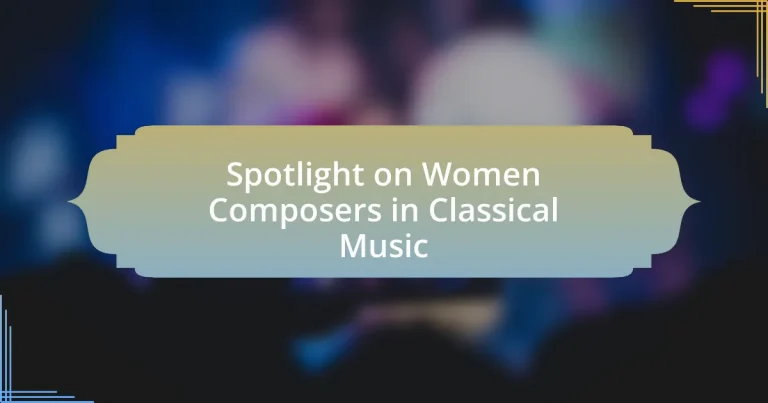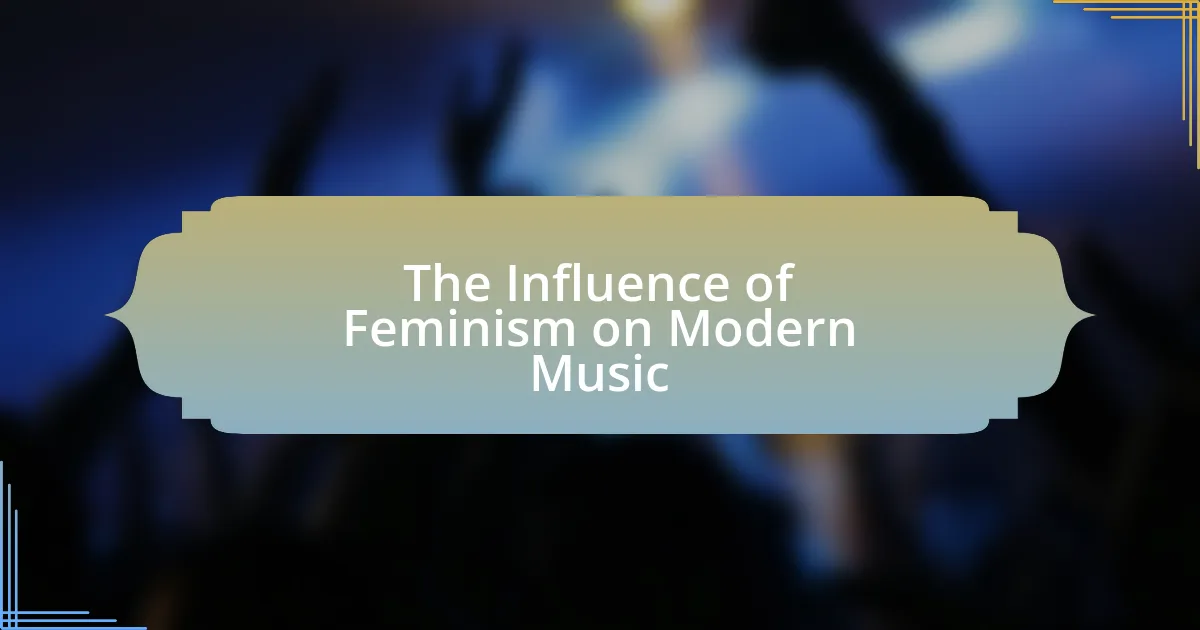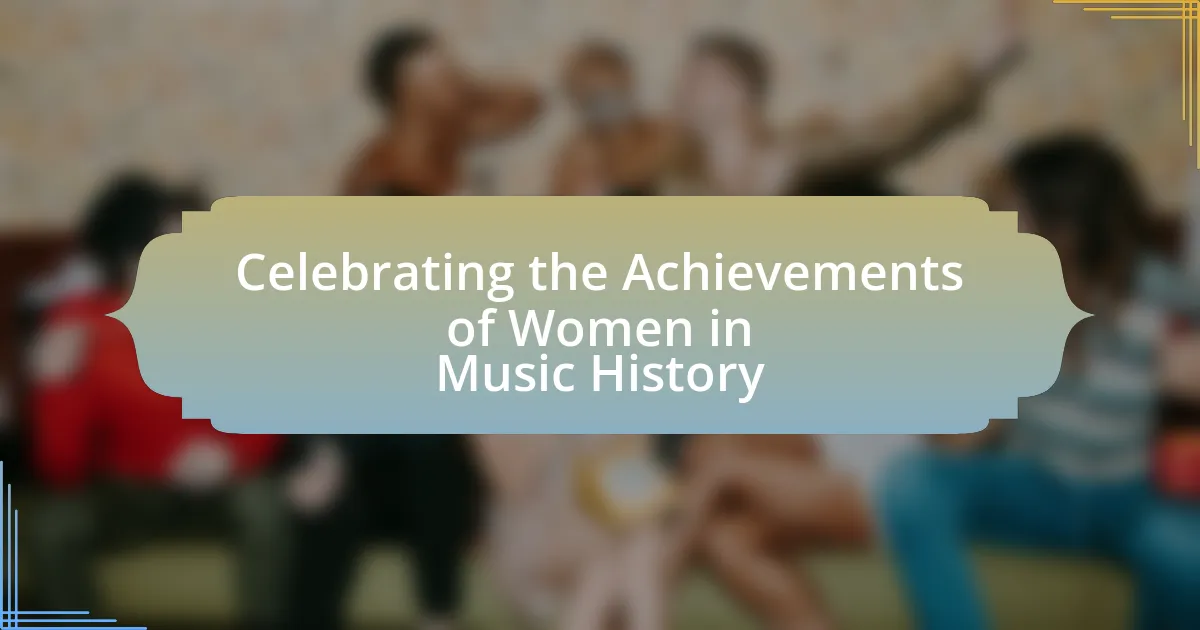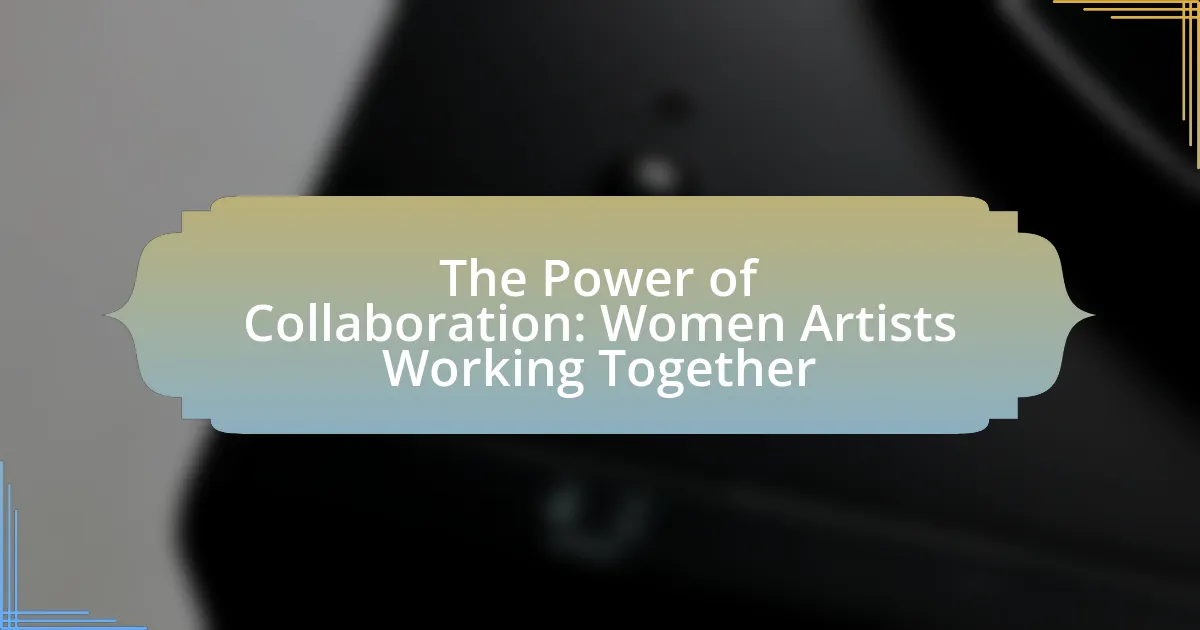The article focuses on the significance of women composers in classical music, highlighting their historical contributions and the barriers they have faced in a predominantly male-dominated field. It discusses notable figures such as Clara Schumann, Fanny Mendelssohn, and contemporary composers like Jennifer Higdon and Kaija Saariaho, emphasizing their influence on the genre’s evolution. The article also examines the societal changes that have improved recognition for women composers, the challenges they continue to face, and the initiatives aimed at promoting gender equity in classical music. Additionally, it provides resources for exploring the works of women composers and strategies for audiences to support their contributions.
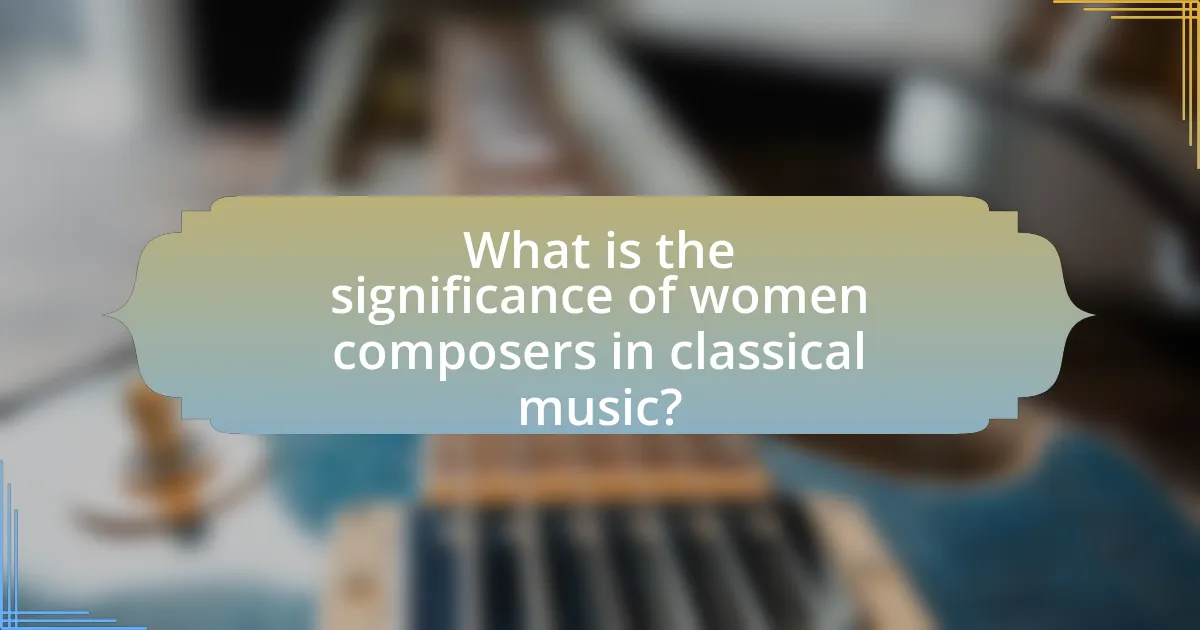
What is the significance of women composers in classical music?
Women composers in classical music are significant for their contributions to the diversity and richness of the genre. Historically, women have faced barriers to entry in the male-dominated field of classical music, yet many have produced influential works that challenge traditional norms. For example, Clara Schumann and Fanny Mendelssohn were pivotal in the 19th century, with Clara’s compositions and performances gaining widespread acclaim, while Fanny’s works were often overshadowed by her brother Felix Mendelssohn. Their legacies highlight the importance of recognizing and celebrating women’s contributions, as they have shaped the evolution of classical music and inspired future generations of female composers. The increasing visibility of women composers today, such as Jennifer Higdon and Kaija Saariaho, further underscores their vital role in contemporary classical music, promoting inclusivity and innovation within the art form.
How have women composers influenced the classical music landscape?
Women composers have significantly influenced the classical music landscape by introducing diverse perspectives and innovative styles. Historical figures such as Clara Schumann and Fanny Mendelssohn challenged societal norms, paving the way for future generations. In contemporary settings, composers like Jennifer Higdon and Kaija Saariaho have expanded the boundaries of classical music through unique compositions that incorporate various genres and modern techniques. Their contributions have not only enriched the repertoire but also fostered greater inclusivity and recognition of women’s roles in music, as evidenced by the increasing number of performances and recordings of works by female composers in recent years.
What historical barriers have women faced in classical music composition?
Women in classical music composition have historically faced barriers such as societal gender norms, lack of access to education, and limited opportunities for performance and recognition. Societal norms often relegated women to domestic roles, discouraging their pursuit of music as a profession. For instance, during the 18th and 19th centuries, women were frequently denied formal training and were often expected to focus on roles as performers rather than composers. Additionally, prominent music institutions and competitions historically favored male composers, further marginalizing women’s contributions. This systemic bias is evidenced by the underrepresentation of women in music history texts and concert programs, which often overlooked their works.
How have societal changes impacted the recognition of women composers?
Societal changes have significantly enhanced the recognition of women composers by challenging traditional gender roles and promoting gender equality in the arts. The feminist movements of the late 20th century, particularly the second wave in the 1960s and 1970s, advocated for women’s rights and visibility in various fields, including music. This advocacy led to increased awareness and appreciation of the contributions of women composers, resulting in more performances, recordings, and scholarly research dedicated to their work. For instance, organizations like the International Alliance for Women in Music have been established to support and promote women composers, further validating their place in the classical music canon.
What are some notable women composers throughout history?
Notable women composers throughout history include Clara Schumann, who was a prominent pianist and composer in the 19th century, and Fanny Mendelssohn, known for her lieder and piano works. Additionally, Amy Beach made significant contributions to American classical music in the late 19th and early 20th centuries, while Florence Price became the first African American woman to have a symphony performed by a major orchestra in 1933. These composers have left a lasting impact on the music world, showcasing their talents in a male-dominated field.
Who were the pioneering women composers in the 18th and 19th centuries?
The pioneering women composers in the 18th and 19th centuries included Fanny Mendelssohn, Clara Schumann, and Louise Farrenc. Fanny Mendelssohn, active in the early 19th century, was known for her lieder and piano works, while Clara Schumann, a prominent pianist and composer, contributed significantly to the Romantic repertoire with her compositions and performances. Louise Farrenc, a French composer, gained recognition for her symphonies and chamber music, becoming one of the first women to hold a professorship at the Paris Conservatory. These women broke barriers in a male-dominated field, establishing their legacies in classical music history.
What contributions did 20th-century women composers make to classical music?
20th-century women composers significantly expanded the repertoire and diversity of classical music. Composers such as Ruth Crawford Seeger, who was the first woman to win a Guggenheim Fellowship in composition, introduced innovative techniques and modernist styles that challenged traditional forms. Similarly, Florence Price became the first African American woman to have a symphony performed by a major orchestra, which helped to pave the way for future generations of composers. Additionally, composers like Lili Boulanger, the first woman to win the Prix de Rome, brought fresh perspectives and emotional depth to their works, influencing the evolution of classical music. These contributions not only enriched the musical landscape but also opened doors for greater representation and recognition of women in the field.
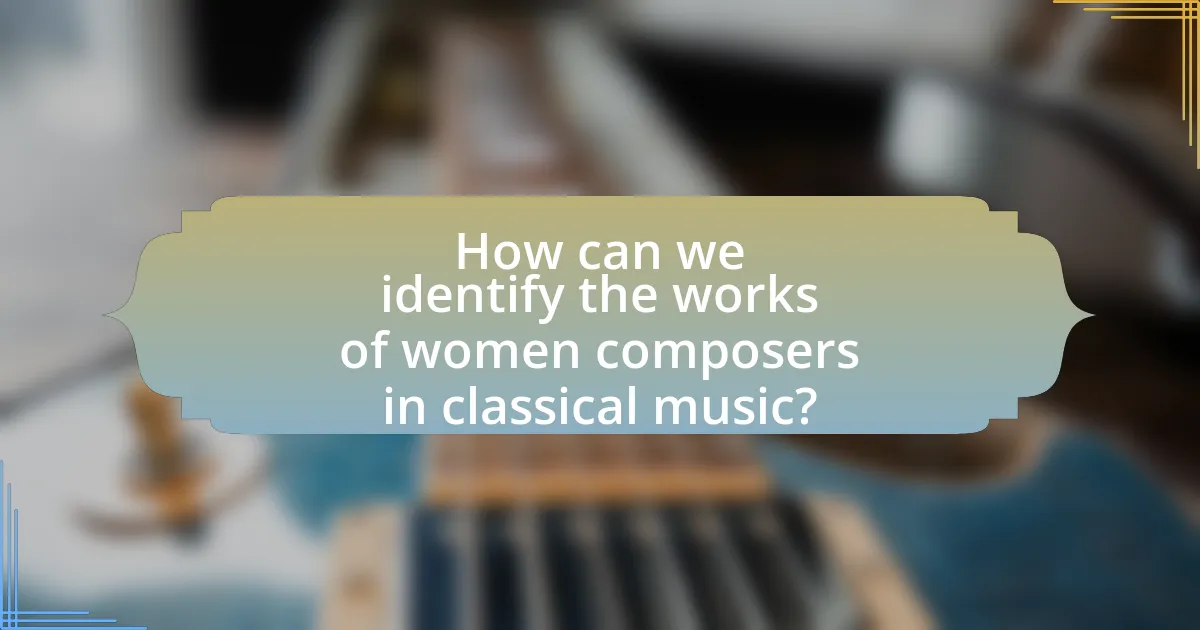
How can we identify the works of women composers in classical music?
To identify the works of women composers in classical music, one can utilize various resources such as music databases, historical texts, and concert programs that specifically highlight their contributions. For instance, databases like the International Music Score Library Project (IMSLP) and the Women Composers Database provide extensive catalogs of compositions by women. Additionally, scholarly works, such as “Women Composers: A History” by Julie Anne Sadie, document the historical context and significance of female composers. Furthermore, music festivals and organizations dedicated to promoting women in music often feature their works, making it easier to discover and recognize their contributions to the classical repertoire.
What characteristics define the compositions of women composers?
The compositions of women composers are often characterized by emotional depth, innovative use of form, and a distinct voice that reflects personal and societal experiences. Women composers frequently explore themes of identity, gender, and social issues, which can be seen in the works of figures like Clara Schumann and Amy Beach, who incorporated their life experiences into their music. Additionally, many women composers utilize diverse musical styles and techniques, blending traditional elements with contemporary influences, as evidenced by the works of contemporary composers like Jennifer Higdon and Kaija Saariaho. This unique approach not only enriches the musical landscape but also challenges conventional norms within classical music.
How do the themes in women composers’ works differ from their male counterparts?
Women composers often explore themes of identity, personal experience, and emotional depth in ways that differ from their male counterparts, who may focus more on abstract concepts or traditional forms. For instance, composers like Clara Schumann and Amy Beach frequently infused their works with autobiographical elements and reflections on societal roles, which can be seen in Beach’s “Gaelic Symphony,” where she incorporates folk elements that resonate with her cultural identity. In contrast, male composers such as Johannes Brahms or Richard Wagner often adhered to established musical forms and grand narratives, emphasizing structural complexity over personal narrative. This thematic divergence highlights how women composers have historically used their music to express unique perspectives shaped by their experiences in a male-dominated field.
What styles and genres are predominantly represented by women composers?
Women composers predominantly represent styles and genres such as classical, contemporary, film music, and jazz. Historical figures like Clara Schumann and Amy Beach contributed significantly to classical music, while contemporary composers like Jennifer Higdon and Kaija Saariaho have expanded the genre with innovative techniques. Additionally, women like Hildur Guðnadóttir have gained recognition in film music, winning awards for their scores. In jazz, figures such as Mary Lou Williams and Esperanza Spalding have made substantial impacts, showcasing the versatility and breadth of women’s contributions across various musical styles.
What resources are available to explore women composers’ music?
Resources available to explore women composers’ music include dedicated databases, online platforms, and published anthologies. For instance, the International Alliance for Women in Music maintains a comprehensive database of works by women composers, while platforms like Spotify and YouTube feature curated playlists highlighting their contributions. Additionally, anthologies such as “Women Composers: A History” by Julie Anne Sadie provide historical context and analysis of their works. These resources collectively facilitate access to the music and contributions of women composers in classical music.
Where can one find recordings and scores of women composers?
Recordings and scores of women composers can be found on platforms such as the International Alliance for Women in Music, which provides a comprehensive database of works by female composers. Additionally, websites like the Women Composers Database and the Classical Music Library offer access to both recordings and scores. These resources are validated by their extensive catalogs that specifically highlight the contributions of women in classical music, ensuring that users can discover a wide range of compositions and performances.
What organizations support the promotion of women composers in classical music?
Organizations that support the promotion of women composers in classical music include the International Alliance for Women in Music, the Women Composers Festival of Hartford, and the American Composers Forum. The International Alliance for Women in Music focuses on advocacy, networking, and providing resources for women composers, while the Women Composers Festival of Hartford showcases the works of women composers through performances and educational events. The American Composers Forum offers grants and opportunities specifically aimed at supporting women in the field of composition. These organizations actively contribute to increasing visibility and opportunities for women composers in the classical music landscape.
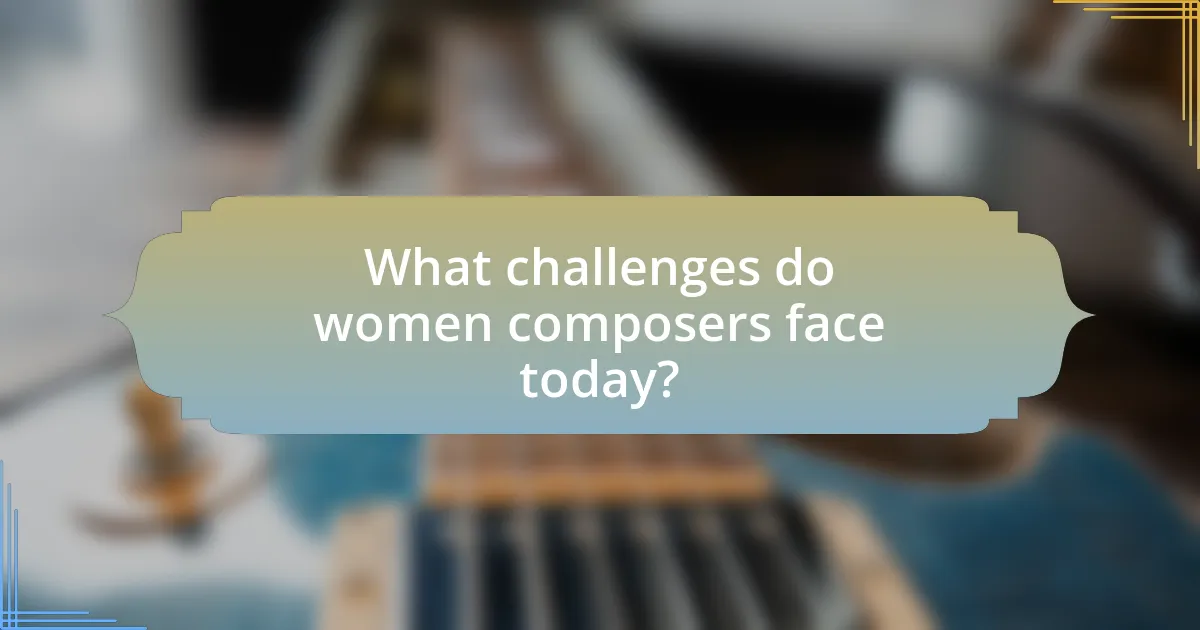
What challenges do women composers face today?
Women composers today face significant challenges, including gender bias, lack of representation, and limited access to funding and performance opportunities. Research indicates that women are underrepresented in classical music, with only 1.5% of works performed by major orchestras being composed by women, according to a study by the League of American Orchestras. Additionally, women often encounter difficulties in securing commissions and grants, which are crucial for their professional development. These systemic barriers contribute to a persistent gender gap in the field, hindering the visibility and recognition of women composers.
How does gender bias affect the opportunities for women composers?
Gender bias significantly limits the opportunities for women composers by perpetuating stereotypes that undervalue their contributions and restrict access to resources. Research indicates that women are often underrepresented in music composition programs and professional opportunities, with studies showing that only 20% of works performed by major orchestras are composed by women. This disparity is further exacerbated by a lack of mentorship and networking opportunities, which are crucial for career advancement in the field. Additionally, societal perceptions often associate composition with male dominance, leading to fewer performances and commissions for women composers, thereby hindering their visibility and recognition in the classical music landscape.
What initiatives are in place to combat gender inequality in classical music?
Initiatives to combat gender inequality in classical music include programs like the “Women Composers Festival of Hartford,” which showcases works by female composers and promotes their visibility. Additionally, organizations such as “Sphinx Organization” focus on increasing diversity in classical music through education and performance opportunities for underrepresented groups, including women. Research indicates that female composers are significantly underrepresented in orchestral programming, with studies showing that only about 1-3% of works performed by major orchestras are by women. These initiatives aim to address this disparity by providing platforms for female talent and advocating for equitable representation in the classical music landscape.
How can audiences support women composers in contemporary classical music?
Audiences can support women composers in contemporary classical music by actively attending their performances and advocating for their works. By purchasing tickets to concerts featuring women composers, audiences directly contribute to their visibility and financial support. Additionally, sharing information about these composers on social media platforms can help raise awareness and encourage others to explore their music. Research indicates that increased exposure leads to greater opportunities for women composers, as evidenced by the growing number of performances and commissions for female composers in recent years.
What are the future prospects for women composers in classical music?
The future prospects for women composers in classical music are increasingly positive, driven by growing recognition and support for gender diversity in the field. Initiatives such as the establishment of awards specifically for women composers, like the ASCAP Foundation’s “Leonard Bernstein Award,” and the increasing number of festivals dedicated to showcasing their work, indicate a shift towards inclusivity. Furthermore, research from the University of California, Los Angeles, highlights that women are now composing a larger percentage of new works performed by major orchestras, rising from 1% in the 1970s to approximately 20% in recent years. This trend suggests that as institutions continue to prioritize diversity, women composers will gain more opportunities for visibility and success in classical music.
How is the landscape of classical music changing for women composers?
The landscape of classical music is changing for women composers through increased visibility, representation, and opportunities within the industry. Initiatives such as the establishment of organizations like the International Alliance for Women in Music and the rise of festivals dedicated to women composers have contributed to this shift. Additionally, data from the 2020 report by the League of American Orchestras indicates that the percentage of works by women composers performed by orchestras has risen from 1.5% in 2015 to 20% in recent seasons, highlighting a significant change in programming and recognition. This evolving landscape reflects a broader commitment to diversity and inclusion in classical music.
What role do education and mentorship play in fostering new women composers?
Education and mentorship are crucial in fostering new women composers by providing them with the necessary skills, knowledge, and support to thrive in a traditionally male-dominated field. Educational programs specifically designed for women in music, such as those offered by institutions like the Berklee College of Music and the Royal College of Music, create an inclusive environment that encourages creativity and collaboration. Mentorship from established composers and industry professionals further enhances this development by offering guidance, networking opportunities, and insights into the music industry. Research indicates that women who have access to mentorship are more likely to succeed in their careers, as highlighted in the study “The Impact of Mentorship on Women in Music” published in the Journal of Music Education Research. This combination of education and mentorship not only empowers women composers but also contributes to a more diverse and innovative musical landscape.
What practical steps can be taken to promote women composers?
To promote women composers, organizations and institutions can implement mentorship programs that connect emerging female composers with established professionals in the field. Research indicates that mentorship significantly enhances career development, as evidenced by a study published in the Journal of Music Education, which found that 70% of mentees reported increased confidence and opportunities in their careers. Additionally, hosting dedicated festivals and competitions that exclusively feature works by women composers can raise visibility and provide performance opportunities, as demonstrated by the success of initiatives like the Women Composers Festival of Hartford. Furthermore, integrating women composers’ works into educational curricula and concert programming can foster greater awareness and appreciation, aligning with findings from the National Endowment for the Arts, which highlights the importance of representation in music education.
How can music educators incorporate women composers into their curricula?
Music educators can incorporate women composers into their curricula by actively including their works in lesson plans and performance repertoire. This can be achieved by selecting pieces from a diverse range of women composers, such as Clara Schumann, Amy Beach, and Florence Price, and integrating them into both historical discussions and practical applications in music classes. Research indicates that representation in music education enhances student engagement and broadens their understanding of the musical landscape, as evidenced by studies showing that students exposed to diverse composers demonstrate increased interest and appreciation for music. By highlighting the contributions of women composers, educators not only enrich their curricula but also promote gender equity in the field of music.
What strategies can audiences use to advocate for women composers’ works?
Audiences can advocate for women composers’ works by actively promoting their music through social media platforms, attending performances, and supporting organizations that focus on gender equity in music. Engaging with and sharing content related to women composers increases visibility and encourages broader recognition of their contributions. For instance, initiatives like the “Women Composers Festival of Hartford” highlight the works of female composers, demonstrating the impact of dedicated platforms in fostering appreciation and support. Additionally, audiences can participate in discussions and forums that emphasize the importance of diversity in classical music, thereby influencing programming decisions in concert halls and educational institutions.
